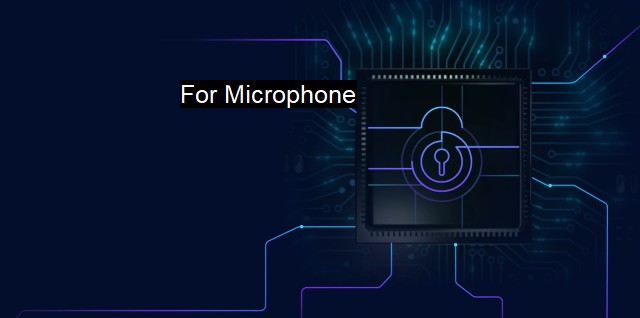What is For Microphone?
The Importance of "For Microphone" Feature: Protecting Against Mic-Based Cyber Attacks and Exploits
In the dynamic realm of cybersecurity, a multitude of devices and communication systems are utilized to transmit data, express ideas and foster connections. These resources come with their own set of hurdles and security risks, necessitating novel strategies and technological advancements to secure these channels against potential threats. A significant and often overlooked instrument in these security schemes is the microphone- a ubiquitous if somewhat covert character in our technological play. The reference to a ‘microphone’ in this context specifies not just about the physical voice recorder, but any grant of an interface for audio, hence a wider conduit to glitch the habitually sung notions of security implementations.The profound nexus between microphones and cybersecurity accrues from a phenomenon termed as ‘eavesdropping attack’- a form of cyberattack that can engage your device microphone to listen to user's conversations without their consent. The operational credibility of this assault is staggeringly extensive - it lists mobile devices, computers, smart devices (like Alexa or Google Home) and even specific programs that utilize microphone permissions. In these cases, malicious cyber actors can exploit your microphone for ill-designated information acquisition, coating into activities categorized in the cyber playbook as unethical and intrusive. Therefore, it becomes increasingly critical to ensure that our devices – especially the data generated via microphone – are properly secured.
Numerous antivirus software and cybersecurity solutions acknowledge the severity of microphone associated risks too. Implementing methods such as regulating access to microphone permissions and safeguarding your firewall configuration are paramount control algorithms settled into software safeguard operations. Cybersecurity enterprises, hence, have incessantly focused on mapping out methodologies aimed to restrict the unsolicited accessibility for microphones. They also include services that promise a secure interface for data transmissions involving microphones along with protective regulations for users, proliferation checks, and galvanizing virtual defense architectures. The cyber-highway for microphone security is a bespoke armamentarium to counter microphone hijacks - a congested gala for data manipulators.
The antivirus systems perform a painstaking analysis examining your programs' and overall systems' microphone use patterns. When an unfamiliar or suspicious pattern evolves, it surfaces as a rogue warning that potentially flags a cyber threat. Consequently, users are instructed to safely maneuver through these microphone-related predicaments by monitoring app permissions, avoiding suspicious downloads or webpages, and keeping software versions up-to-date.
As we enter a new phase of digital consciousness, with smart devices booming in every household, the notion of ‘for microphone’ blends a deeper responsibility for cybersecurity mechanisms. Users are urged to be weary not only of physical malware and breaches but also by the subtler invasions brought forth by an inadequately secured microphone. The cybersecurity ambiance, therefore, does not stop at ensuring that your video and data are encrypted. It furthers the chapter by evolving strategies and reinforcing strategies to guard your microphone - an often intimidating vacuum left in our thinking of information security puzzle.
Besides, the discourse over smart voice assistants and IoT devices revealed another avenue of microphone vulnerabilities - cross-device eavesdropping or ‘audio spamming’. This feature permits adversarial attackers to deliver encrypted messages to users via connected devices, thereby intercepting the user’s information without triggering any suspicion. Accordingly, mitigating these obtrusive microphone-related threats necessitate a rigorous, comprehensive scheme from antivirus software and cybersecurity solutions.
Therefore, in the purview of cybersecurity and antivirus protection, the focus on a ‘microphone’ brings to light a tamilizing frontier with reverberating yet subtle potential threats. It reiterates the importance of implementing advanced security measures to counter these negativities and protect users from rogue invasions. A simple, everyday gadget like a microphone can twist from benign to malicious, highlighting the evolving interplay gadgets hold within the wide canvas of cybersecurity. This complicates an already chaotic world, but cybersecurity aims to manage and massively minimize these risks. As the cybersecurity sphere keeps evolving, our understanding of ‘for microphone’ must equally transform flexibly too.

| | A | | | B | | | C | | | D | | | E | | | F | | | G | | | H | | | I | | | J | | | K | | | L | | | M | |
| | N | | | O | | | P | | | Q | | | R | | | S | | | T | | | U | | | V | | | W | | | X | | | Y | | | Z | |
| | 1 | | | 2 | | | 3 | | | 4 | | | 7 | | | 8 | | |||||||